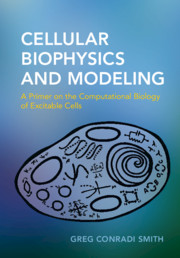
-
Select format
-
- Publisher:
- Cambridge University Press
- Publication date:
- March 2019
- March 2019
- ISBN:
- 9780511793905
- 9781107005365
- 9780521183055
- Dimensions:
- (247 x 174 mm)
- Weight & Pages:
- 0.92kg, 394 Pages
- Dimensions:
- (247 x 174 mm)
- Weight & Pages:
- 0.78kg, 394 Pages
You may already have access via personal or institutional login
Book description
What every neuroscientist should know about the mathematical modeling of excitable cells. Combining empirical physiology and nonlinear dynamics, this text provides an introduction to the simulation and modeling of dynamic phenomena in cell biology and neuroscience. It introduces mathematical modeling techniques alongside cellular electrophysiology. Topics include membrane transport and diffusion, the biophysics of excitable membranes, the gating of voltage and ligand-gated ion channels, intracellular calcium signalling, and electrical bursting in neurons and other excitable cell types. It introduces mathematical modeling techniques such as ordinary differential equations, phase plane, and bifurcation analysis of single-compartment neuron models. With analytical and computational problem sets, this book is suitable for life sciences majors, in biology to neuroscience, with one year of calculus, as well as graduate students looking for a primer on membrane excitability and calcium signalling.
Reviews
'In this text, Conradi Smith does an excellent job of teaching students with no mathematical training beyond calculus how to use differential equations to understand the basic principles of cell physiology and excitability. He skilfully walks students through the steps of modeling and analysis, all the while working to develop intuition and insight into how things work. His emphasis on computational methods for solution as well as graphical and geometrical means for interpretation enables him to communicate complex ideas in understandable ways. Furthermore, his patience and attention to detail will be appreciated by those students who have not had extensive exposure to the art of mathematical modeling. This text is a wonderful addition to the mathematical biology textbook literature.'
James P. Keener - University of Utah
Contents
Metrics
Altmetric attention score
Full text views
Full text views help Loading metrics...
Loading metrics...
* Views captured on Cambridge Core between #date#. This data will be updated every 24 hours.
Usage data cannot currently be displayed.
Accessibility standard: Unknown
Why this information is here
This section outlines the accessibility features of this content - including support for screen readers, full keyboard navigation and high-contrast display options. This may not be relevant for you.
Accessibility Information
Accessibility compliance for the PDF of this book is currently unknown and may be updated in the future.


